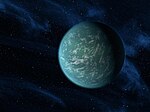 Animation of 2011 QF99 relative to Sun and Uranus 1600-2500 Animation of 2011 QF99 relative to Sun and Uranus 1600-25002011 QF99 · Uranus · Sun | |
| Discovery | |
|---|---|
| Discovered by | M. Alexandersen |
| Discovery site | Mauna Kea Obs. |
| Discovery date | 29 August 2011 (first observation only) |
| Designations | |
| MPC designation | 2011 QF99 |
| Minor planet category | Uranus trojan centaur · distant |
| Orbital characteristics | |
| Epoch 4 September 2017 (JD 2458000.5) | |
| Uncertainty parameter 3 | |
| Observation arc | 3.97 yr (1,449 days) |
| Aphelion | 22.422 AU |
| Perihelion | 15.659 AU |
| Semi-major axis | 19.040 AU |
| Eccentricity | 0.1776 |
| Orbital period (sidereal) | 83.08 yr (30,346 days) |
| Mean anomaly | 283.84° |
| Mean motion | 0° 0 42.84 / day |
| Inclination | 10.833° |
| Longitude of ascending node | 222.52° |
| Argument of perihelion | 288.25° |
| Physical characteristics | |
| Mean diameter | 60 km (calculated) |
| Geometric albedo | 0.05 (assumed) |
| Absolute magnitude (H) | 9.6 (R-band) 9.7 |
(687170) 2011 QF99 is a minor planet from the outer Solar System and the first known Uranus trojan to be discovered. It measures approximately 60 kilometers (37 miles) in diameter, assuming an albedo of 0.05. It was first observed 29 August 2011 during a deep survey of trans-Neptunian objects conducted with the Canada–France–Hawaii Telescope, but its identification as Uranian trojan was not announced until 2013.
2011 QF99 temporarily orbits near Uranus's L4 Lagrangian point (leading Uranus). It will continue to librate around L4 for at least 70,000 years and will remain a Uranus co-orbital for up to three million years. 2011 QF99 is thus a temporary Uranus trojan—a centaur captured some time ago.
Uranus trojans are generally expected to be unstable and none of them are thought to be of primordial origin. A simulation led to the conclusion that at any given time, 0.4% of the centaurs in the scattered population within 34 AU would be Uranus co-orbitals, of which 64% (0.256% of all centaurs) would be in horseshoe orbits, 10% (0.04%) would be quasi-satellites, and 26% (0.104%) would be trojans (evenly split between the L4 and L5 groups). A second Uranian Trojan, 2014 YX49, was announced in 2017.
References
- ^ "2011 QF99". Minor Planet Center. Retrieved 12 October 2017.
- ^ "JPL Small-Body Database Browser: (2011 QF99)" (2012-10-21 last obs.). Jet Propulsion Laboratory. Retrieved 12 October 2017.
- ^ Alexandersen, M.; Gladman, B.; Greenstreet, S.; Kavelaars, J. J.; Petit, J. -M.; Gwyn, S. (2013). "A Uranian Trojan and the Frequency of Temporary Giant-Planet Co-Orbitals". Science. 341 (6149): 994–997. arXiv:1303.5774. Bibcode:2013Sci...341..994A. doi:10.1126/science.1238072. PMID 23990557. S2CID 39044607.
- Choi, C. Q. (29 August 2013). "First 'Trojan' Asteroid Companion of Uranus Found". Space.com web site. TechMediaNetwork. Retrieved 3 September 2013.
- Alexandersen, M.; Kavelaars, J.; Petit, J.; Gladman, B. (18 March 2013). "MPEC 2013-F19: 2011 QF99". Minor Planet Electronic Circulars. 2013-F19. IAU. Bibcode:2013MPEC....F...19A. Retrieved 3 September 2013.
- de la Fuente Marcos, Carlos; de la Fuente Marcos, Raúl (22 May 2014). "Comparative orbital evolution of transient Uranian co-orbitals: exploring the role of ephemeral multibody mean motion resonances". Monthly Notices of the Royal Astronomical Society. 441 (3): 2280–2295. arXiv:1404.2898. Bibcode:2014MNRAS.441.2280D. doi:10.1093/mnras/stu733.
- de la Fuente Marcos, Carlos; de la Fuente Marcos, Raúl (15 May 2017). "Asteroid 2014 YX49: a large transient Trojan of Uranus". Monthly Notices of the Royal Astronomical Society. 467 (2): 1561–1568. arXiv:1701.05541. Bibcode:2017MNRAS.467.1561D. doi:10.1093/mnras/stx197.
External links
| Uranus | |||||||
|---|---|---|---|---|---|---|---|
| Geography | |||||||
| Major moons | |||||||
| Astronomy |
| ||||||
| Exploration |
| ||||||
| Related | |||||||
| Minor planets navigator | |
|---|---|
| Small Solar System bodies | |||||||
|---|---|---|---|---|---|---|---|
| Minor planets |
| ||||||
| Comets | |||||||
| Other | |||||||
| 2011 in space | ||
|---|---|---|
| 2012 » | ||
| Space probe launches |
|    |
| Selected NEOs | ||
| Exoplanets |
| |
| Discoveries | ||
| Novae | ||
| Comets | ||
| Space exploration | ||